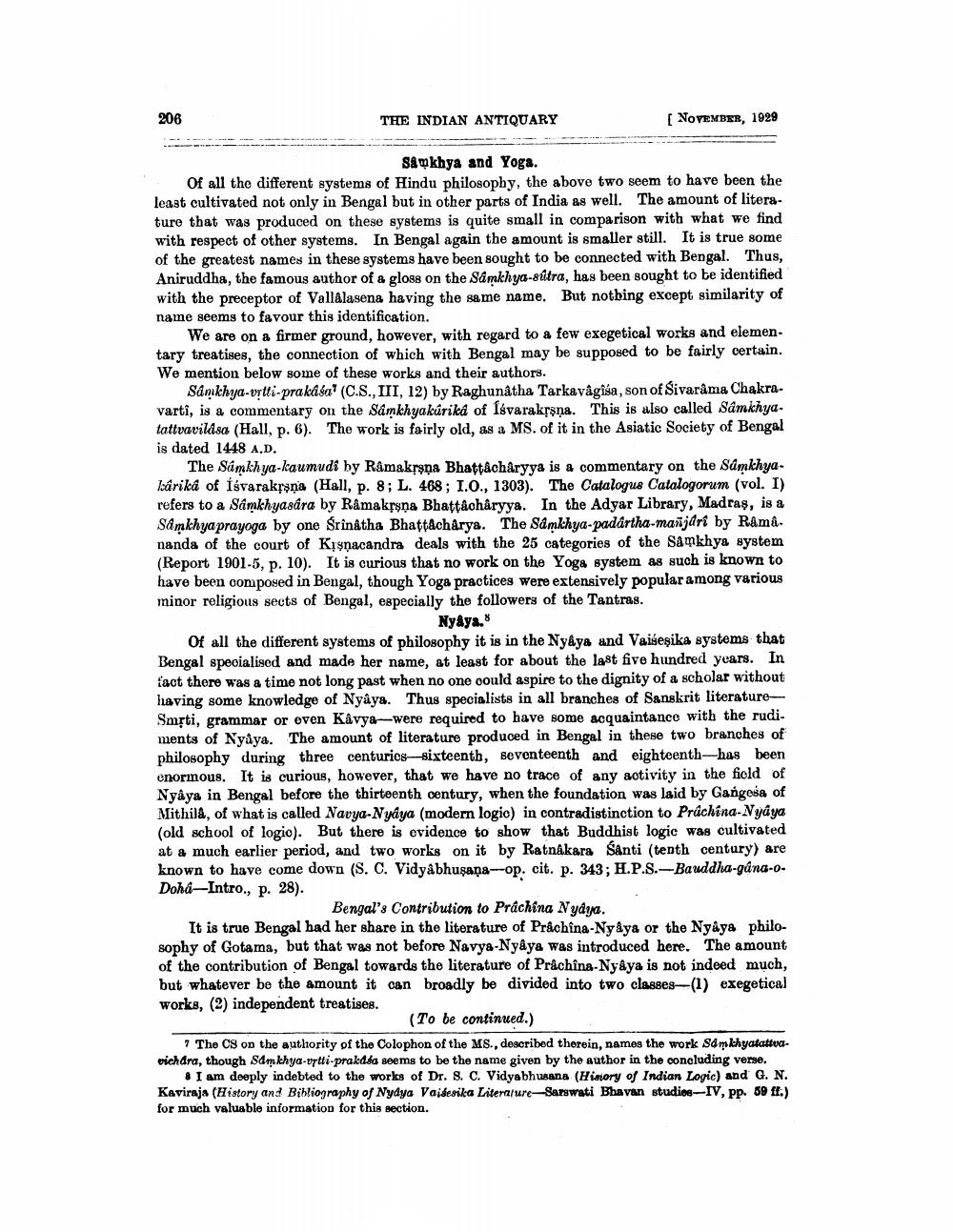________________
206
THE INDIAN ANTIQUARY
[ NOVEMBER, 1929
Sau khya and Yoga. Of all the different systems of Hindu philosophy, the above two seem to have been the least cultivated not only in Bengal but in other parts of India as well. The amount of literature that was produced on these systems is quite small in comparison with what we find with respect of other systems. In Bengal again the amount is smaller still. It is true some of the greatest names in these systems have been sought to be connected with Bengal. Thus, Aniruddha, the famous author of a gloss on the Samkhya-sútra, has been sought to be identified with the preceptor of Vallalasena having the same name. But nothing except similarity of name seems to favour this identification.
We are on a firmer ground, however, with regard to a few exegetical works and elementary treatises, the connection of which with Bengal may be supposed to be fairly certain. We mention below some of these works and their authors.
Sankhya-vrtti-prakasz" (C.S.,III, 12) by Raghunatha Tarkavågiša, son of Sivarama Chakravartî, is a commentary on the Samkhyakúrika of Íśvarakrsna. This is also called Samkhyatattvavilasa (Hall, p. 6). The work is fairly old, as a MS. of it in the Asiatic Society of Bengal is dated 1448 A.D.
The Sámkhya-kaumudi by Ramakrsna Bhattacharyya is a commentary on the Samkhyakárika of Isvarakrana (Hall, p. 8; L. 468; 1.0., 1303). The Catalogus Catalogorum (vol. I) refers to a Sámkhyasdra by Ramakrsna Bhattacharyya. In the Adyar Library, Madras, is a sankhya prayoga by one Srinatha Bhattacharya. The Samkhya-padártha-mañjdri by Rama. nanda of the court of Kışnacandra deals with the 25 categories of the Samkhya system (Report 1901-5, p. 10). It is curious that no work on the Yoga system as such is known to have been composed in Bengal, though Yoga practices were extensively popular among various minor religious sects of Bengal, especially the followers of the Tantras.
NYBY.8 Of all the different systems of philosophy it is in the Nyâya and Vaiseșika systems that Bengal specialised and made her name, at least for about the last five hundred years. In fact there was a time not long past when no one could aspire to the dignity of a scholar without having some knowledge of Nyâya. Thus specialists in all branches of Sanskrit literatureSmrti, grammar or even Kavya-were required to have some acquaintance with the rudiments of Nyâya. The amount of literature produced in Bengal in these two branches of philosophy during three centurios-sixteenth, seventeenth and eighteenth has been enormous. It is curious, however, that we have no trace of any activity in the field of Nyåya in Bengal before the thirteenth century, when the foundation was laid by Gangesa of Mithila, of what is called Navya-Nyaya (modern logic) in contradistinction to Průchina-Nyaya (old school of logio). But there is evidence to show that Buddhist logic was cultivated at a much earlier period, and two works on it by Ratnakara Santi (tenth century) are known to have come down (S. C. Vidyabhuşaņa--op. cit. p. 343; H.P.S.-Bauddha-gána-oDoha-Intro., p. 28).
Bengal's Contribution to Prachina Nydya. It is true Bengal had her share in the literature of Prachina-Nyaya or the Nyâya philosophy of Gotama, but that was not before Navya-Nyaya was introduced here. The amount of the contribution of Bengal towards the literature of Prachina-Nyâya is not indeed much, but whatever be the amount it can broadly be divided into two classes-(1) exegetical works, (2) independent treatises.
(To be continued.) 7 The C8 on the authority of the Colophon of the MS., described therein, names the work Samkhyalattuavichdra, though Samkhya-vrtti-prakd.da seems to be the name given by the author in the concluding verse.
# I am deeply indebted to the works of Dr. 8. C. Vidyabhusana (Himory of Indian Logic) and G. N. Kaviraja (History and Bibliography of Nydya Vaidesika Literature-Sarswati Bhavan studios--IV, pp. 69 ff.) for much valuable information for this section.




